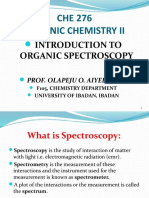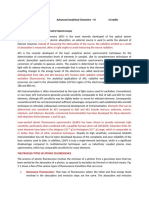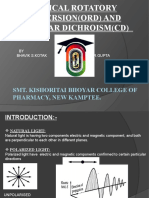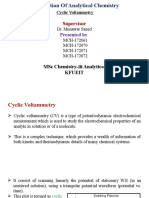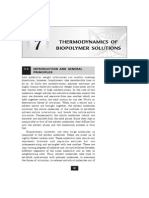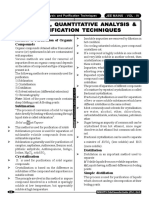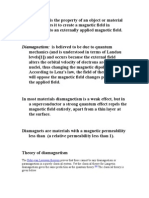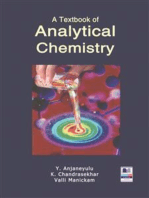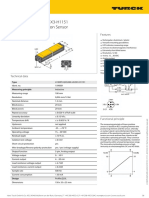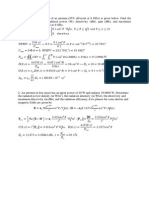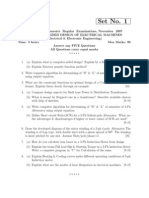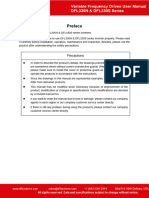ESR For TY As Handout
ESR For TY As Handout
Uploaded by
Pavitra JonesCopyright:
Available Formats
ESR For TY As Handout
ESR For TY As Handout
Uploaded by
Pavitra JonesOriginal Description:
Original Title
Copyright
Available Formats
Share this document
Did you find this document useful?
Is this content inappropriate?
Copyright:
Available Formats
ESR For TY As Handout
ESR For TY As Handout
Uploaded by
Pavitra JonesCopyright:
Available Formats
INDEX:
1.
2.
3.
4.
5.
6.
7.
What is ESR?
Basis of ESR spectroscopy
Energy states of electron
ESR spectrum
Field for resonance
Hyperfine coupling
Hyperfine splitting pattern
(ESR spectra of methyl free radical
and isobutyl free radical)
8. Advantages and Disadvantages.
WHAT IS ESR SPECTROSCOPY?
Electron Spin Resonance Spectroscopy, also referred to
as Electron Paramagnetic Resonance Spectroscopy is a
versatile and non-destructive analytical technique which
can be used for variety of application including oxidation
and reduction processes, reaction kinetics as well as
additional application in biology, medicine and physics.
However, this technique can only be applied to samples
having one or more unpaired electrons.
Spectroscopy is the measurement and interpretation of
the energy difference between atomic or molecular
states. According to Planks Law, electromagnetic
radiation will be absorbed if
E=h
Where E difference in energy of the two states
And h Planks constant
Frequency of the radiation.
The absorption of this energy causes a transition of an
electron from the lower energy state to the higher
energy state.
In ESR spectroscopy, the radiation used is in the
gigahertz range. Unlike most traditional spectroscopy
technique, in ESR spectroscopy the frequency of the
radiation is held constant while the magnetic field is
varied in order to obtain an absorption spectrum
BLOCK DIAGRAM FOR A TYPICAL ESR SPECTROMETER
BASIS OF ESR SPECTROSCOPY
The basis of ESR spectroscopy lies in the spin of an
electron and its associated magnetic moment. When
an electron is placed within an applied magnetic field B0,
the two possible spin state of the electron have
different energies. This energy difference is a result
of the Zeeman Effect.
Zeeman Effect: Its the effect of splitting a spectral
line into several components in the presence of
magnetic field.
The lower energy occurs when the magnetic moment of
the electron, , is aligned with the magnetic field
and higher energy state occurs when the is aligned
against the magnetic field.
The two states are labelled by the projection of
the electron spin, Ms, on the direction of the magnetic
field,
Where Ms =-1/2 is the parallel state
Ms =+1/2 is the anti-parallel state
An unpaired electron can move between the two energy
levels by either absorbing or emitting a photon of
energy h , such that the resonance condition, h =E, is
obeyed.
ENERGY STATES OF THE ELECTRONSo for a molecule with one unpaired electron in a
magnetic field, the energy state of the electron can be
defined as
E = g B B0 M s
= 1/2 g B B0
since Ms =1/2
Where g- the proportionality factor
B- Bohr Magneton
B0- magnetic field
Ms- Electron spin quantum number
From the relationship ie E = g B B0 Ms
There are two important factors to NOTE:
The two spin state have the same energy when
there is no applied magnetic field.
The energy difference between the two spin states
increase linearly with the increasing magnetic field
strength.
ESR SPECTRUM
Like most spectroscopic technique, when the radiation
is absorbed, a spectrum is produced similar to the one
shown above (left).
But in ESR spectrometer, a phase-sensitive detector is
used and this results in the absorption signal being
present as the first derivative as shown above (right).
So the absorption maximum corresponds to the point
where spectrum passes through zero. This is the point
that is used to determine the centre of the signal.
FIELD FOR RESONANCE
We know that, ESR spectrum is obtained by holding the
frequency of radiation constant and varying the
magnetic field tunes the two spins so that their
energy difference is equal to the radiation. This is
known as field for resonance. As spectra can be
obtained at variety of frequencies, the field for
resonance does not provide unique identification of
compound.
The proportionality factor, however, can yield more
useful information.
g = h / BB0
For a free electron, the proportionality factor is
2.00232
For an organic radical, the value is typically quite close
to that of a free electron with values ranging from
1.99-2.01
For transition metal compounds, large variations can
occur due to spin orbit coupling and zero-field splitting,
resulting in values ranging from 1.4-3.0
NOTE: 1. In addition to the applied magnetic field
unpaired electrons are also sensitive to their local
environment.
2.The ESR spectrum of a free radical with one
unpaired electron is the simplest of all forms of
spectroscopy.
HYPERFINE COUPLING:
Since the source of an ESR spectrum is a change in an
electrons spin state, it might be thought that all ESR
spectra for a single electron spin would consist of
just one line. But frequently the nuclei of the atoms in
a molecule or complex have magnetic moment which
produces a local magnetic field at the electron.
This results in the interaction between the electron
and the nuclei. Thus, the interaction of an unpaired
electron by way of its magnetic moment with nearby
nuclear spins results in additional allowed energy
states and in turn multi-lined spectra.
The spacing between the ESR spectral lines indicate
the degree of interaction between the unpaired
electron and the perturbing nuclei. The hyperfine
coupling constant of a nucleus is directly related to the
spectral line spacing and in simplest cases is essentially
the spacing itself.
Thus, in real system, electrons are not normally alone,
but are associated with one or more atoms. There are
several important consequences of this:
(a) An unpaired electron can gain or lose angular
momentum, which can change the value of its
proportionality factor. This is especially
significant for chemical systems with transition
metal ions.
10
(b) If an atom with an unpaired electron is
associated, has a non-zero nuclear spins, then its
magnetic moment will affect the electron and,
this leads to the phenomenon of hyperfine
coupling which is similar to J-coupling in NMR,
also this splits the ESR resonance signal into
doublet, triplet and so forth.
(c) The interaction of an unpaired electron with its
environment influence the shape of an ESR
spectral lines. These line shapes can yield
information about like for ex: rate of chemical
reaction.
HYPERFINE SPLITTING PATTERN:
The hyperfine splitting pattern for a radical freely
moving in a solution can be predicted.
(1) For a radical having M equivalent nuclei, each with
spin of l, the number of ESR lines expected is
2Ml + 1.
Example: the methyl radical CH3, has three H (protium)
nuclei each with l =1/2, and the number of lines
11
expected is 2M + l.
ie 2(3)(1/2) +1 = 4
Thus 4 lines are expected in the ESR spectrum.and
which is actually observed.
ESR SPECTRUM OF METHYL FREE RADICAL
x-axis : magnectic field
y-axis : first derivative of adsorption.
(2) For a radical having M1 equivalent nuclei each with
l1 and a group of M2 equivalent nuclei,
each with a spin of l2, the number of lines
expected is (2M1l +1)(2M2l + +1)
a spin of
12
EXAMPLE: for isobutyl radical the number of ESR lines
expected is
[2(6)(1/2) +1)] [2(3)(1/2) + 1] = 28
Thus 28 lines are expected in its ESR spectra.
ADVANTAGES AND DISADVANTAGES:
Its helps us know the properties of the
electron in the free radical that any
compound have.
PROCESS: During any physical activity like
the bombardment of some huge amount of
energy like light, microwave radiation, or even
heat on say ice (water) some free radicals like
H ,OH, OH2 will be formed and in the process
the ice liquidizes into water. These radicals
sometimes get attached to a location and
when ESR is applied, using a specific
spectroscope the analysis of the cell can be
done.
This is possible because the radiation of the
energy used together with an alternating
magnetic field causes the electrons to move
between their low and high orbits back and
13
forth. They start moving faster and faster as
more and more energy is picked up when they
move so. Then the gap between their low and
high orbits becomes smaller as time passes
by. The energy applied gets in between the
gap created and the difference in the energy
levels can be detected by the sensor used for
this purpose.
This application is widely used in the field of
biology and also medicine. There are some
key advantages. The first being it is the
speed with which it can be performed and
yet the analysis of the free radicals is
found to be near perfect. Moreover, the
results of the testing pretty easy to
comprehend and understand. Other
techniques are used to identify free
radicals and also electrons in pairs. This
spectroscopy is used for the purpose of
identification of only free radicals. This is
an important aspect in the study of free
radicals.
14
Likewise there are some disadvantages too.
The foremost is that this process should be
performed at low temperature and inly then
desired results can be got. So they are
performed in the specific laboratories where
such temperature can be attained.
15
You might also like
- Deviation Card PDFDocument2 pagesDeviation Card PDFBf IpanemaNo ratings yet
- Easson-Stedman HypothesisDocument1 pageEasson-Stedman HypothesisSudip KarNo ratings yet
- Transport Properties of The Gas (Physical Chemistry 2)Document29 pagesTransport Properties of The Gas (Physical Chemistry 2)Adilla Rizka Yonita100% (1)
- Concept of Electrical InterlocksDocument16 pagesConcept of Electrical InterlockssubhraNo ratings yet
- Sem-III - Unit - IV (NQR and Epr Spectroscopy)Document46 pagesSem-III - Unit - IV (NQR and Epr Spectroscopy)PG ChemistryNo ratings yet
- 3 Rotational Spectroscopy1Document19 pages3 Rotational Spectroscopy1Omprakash LatiyalNo ratings yet
- Magnetic Properties of Transition Metal Metal ComplexesDocument9 pagesMagnetic Properties of Transition Metal Metal ComplexestharanginiNo ratings yet
- Lecture 8 Colloids Electrokinetic PhenomenonDocument33 pagesLecture 8 Colloids Electrokinetic PhenomenonJunaid Parker0% (1)
- Unit IV IR SpectroscoptyDocument37 pagesUnit IV IR SpectroscoptyNTGNo ratings yet
- Fluorescence and PhosphorescenceDocument6 pagesFluorescence and PhosphorescenceUmar Farooq MughalNo ratings yet
- Jahn-Teller TheormDocument12 pagesJahn-Teller TheormTuba AhmedNo ratings yet
- Electron Transfer in BiologyDocument20 pagesElectron Transfer in BiologyVani KaushikNo ratings yet
- LCAO MO Theory Illustrated by Its Application To H2Document8 pagesLCAO MO Theory Illustrated by Its Application To H2maugonzalezsuarezNo ratings yet
- CHE 276 PPT - Introduction To Organic SpectrosDocument8 pagesCHE 276 PPT - Introduction To Organic SpectrosEmmy OlabosipoNo ratings yet
- Stripping VoltammetryDocument12 pagesStripping Voltammetry20tamilselvi-ugche100% (1)
- Electrokinetic Phenomenon FinalDocument12 pagesElectrokinetic Phenomenon FinalRithika Prasad SaniNo ratings yet
- Chem. 21313 Advanced Analytical Chemistry - III 4 CreditsDocument14 pagesChem. 21313 Advanced Analytical Chemistry - III 4 CreditsCheska Mae E. Manuel100% (1)
- Smt. Kishoritai Bhoyar College of Pharmacy, New Kamptee.: BY Guided by Bhavik S.Kotak Dr. K.R.GuptaDocument33 pagesSmt. Kishoritai Bhoyar College of Pharmacy, New Kamptee.: BY Guided by Bhavik S.Kotak Dr. K.R.Guptadil_009100% (3)
- Introduction To MagnetochemistryDocument8 pagesIntroduction To MagnetochemistryMuhammad ZubairNo ratings yet
- Unit Iii Drawbacks of Bohr and Sommerfeld Atom Model:: QuantizationDocument9 pagesUnit Iii Drawbacks of Bohr and Sommerfeld Atom Model:: QuantizationNaval Sabe100% (1)
- Band Theory of ConductorsDocument29 pagesBand Theory of ConductorsSivakumar PonnusamyNo ratings yet
- Organometallic Chemistry: Historical BackgroundDocument82 pagesOrganometallic Chemistry: Historical BackgroundĐức ThànhNo ratings yet
- Standard Hydrogen ElectrodeDocument2 pagesStandard Hydrogen ElectrodeAmmara Amy100% (1)
- Chemical KineticsDocument108 pagesChemical KineticsManas ranjan BeheraNo ratings yet
- Gouy Method For Magnetic SusceptibilityDocument6 pagesGouy Method For Magnetic Susceptibility2zl3gaNo ratings yet
- Piezo, Ferro & Pyro Electric MaterialsDocument14 pagesPiezo, Ferro & Pyro Electric Materialsyannazmi100% (1)
- Experiment - Determination of Angle of Rotation of A Sugar Solution. Organic Chemistry II Lab ManualDocument5 pagesExperiment - Determination of Angle of Rotation of A Sugar Solution. Organic Chemistry II Lab Manualusman1200550% (1)
- Unit 3 Potentiometry-II (PH Metry)Document24 pagesUnit 3 Potentiometry-II (PH Metry)Nathanian100% (1)
- Irreversible ThermodynamicsDocument2 pagesIrreversible ThermodynamicsManoj PrakashNo ratings yet
- UNIT 8.d&f-BLOCK ELEMENTSDocument14 pagesUNIT 8.d&f-BLOCK ELEMENTS16739No ratings yet
- Introduction To Inorganic PhotochemistrypdfDocument6 pagesIntroduction To Inorganic Photochemistrypdfjayaprabha KNNo ratings yet
- FluxionalityDocument28 pagesFluxionalityVicky ChaharNo ratings yet
- NMR Spectros PDFDocument14 pagesNMR Spectros PDFAnonymous XX9Om322lNo ratings yet
- HMBC and HMQCDocument13 pagesHMBC and HMQCArthur Girardi CarpanezNo ratings yet
- Nuclear Magnetic Resonance of ProtonsDocument43 pagesNuclear Magnetic Resonance of ProtonsJohnathan InarrittuNo ratings yet
- Electroanalytical ChemistryDocument4 pagesElectroanalytical ChemistrybelleNo ratings yet
- Electrodes and PotentiometryDocument26 pagesElectrodes and PotentiometryMegha AnandNo ratings yet
- Lambert-Beer's LawDocument1 pageLambert-Beer's LawRAGHAV SHARMANo ratings yet
- Ord & CDDocument30 pagesOrd & CDSaravana KumarNo ratings yet
- X Rays Thomson Mass SpectrographDocument3 pagesX Rays Thomson Mass SpectrographNitin SharmaNo ratings yet
- GATE Chemistry PDFDocument3 pagesGATE Chemistry PDFd anjilappa100% (1)
- A Brief Introduction To Cyclic VoltammetryDocument10 pagesA Brief Introduction To Cyclic VoltammetrySafooraShabbirNo ratings yet
- Introduction To Magneto ChemistryDocument7 pagesIntroduction To Magneto ChemistryYousuf Raza100% (1)
- Potentiometer Chemistry Viva Questions Part 2Document2 pagesPotentiometer Chemistry Viva Questions Part 2monika vermaNo ratings yet
- Isomerism in Coordination ChemistryDocument21 pagesIsomerism in Coordination Chemistrym.nouraldenNo ratings yet
- Cyclic Voltammetric Study of Ferrocyanide - Ferricyanide Redox CoupleDocument3 pagesCyclic Voltammetric Study of Ferrocyanide - Ferricyanide Redox CouplePARUL KUMAR SHARMA50% (2)
- 7Document19 pages7Shibu KumardNo ratings yet
- Introduction To Colossal Magneto ResistanceDocument18 pagesIntroduction To Colossal Magneto ResistanceJogesh SinghNo ratings yet
- Thermoelectric EffectDocument5 pagesThermoelectric EffectUday Khanal100% (1)
- 03-Purification of Organic Compo CWDocument25 pages03-Purification of Organic Compo CWvramaanuNo ratings yet
- Langevin of DiamagnetismDocument6 pagesLangevin of Diamagnetismlakshmi2811No ratings yet
- Classification of Materials Based On Energy Band TheoryDocument3 pagesClassification of Materials Based On Energy Band Theoryarpit mamarNo ratings yet
- Determination of Magnetic Susceptibility of A Paramagnetic Material by Quincke's MethodDocument4 pagesDetermination of Magnetic Susceptibility of A Paramagnetic Material by Quincke's MethodSajag KumarNo ratings yet
- Lab Experiment - 1: Solid State Physics LabDocument16 pagesLab Experiment - 1: Solid State Physics LabAman bansalNo ratings yet
- CHRONOPOTENTIOMETRYDocument11 pagesCHRONOPOTENTIOMETRYTahira AzamNo ratings yet
- CHEM 430 NMR Spectroscopy Chapter 3Document97 pagesCHEM 430 NMR Spectroscopy Chapter 3Praveen kumar100% (1)
- Structural Effect On ReactivityDocument16 pagesStructural Effect On ReactivityMarla BasaNo ratings yet
- Woodward-Hoffmann RulesDocument2 pagesWoodward-Hoffmann Rulesjyothirlatha venkata nageswariNo ratings yet
- EP103 Sen LNT 003d Sep11Document16 pagesEP103 Sen LNT 003d Sep11Sàtz ÑÖÑït0% (1)
- Born Oppenheimer PPT Riya NEWDocument15 pagesBorn Oppenheimer PPT Riya NEWriya dutta sharmaNo ratings yet
- Assignment #2 SolvedDocument50 pagesAssignment #2 SolvedHéctor Manuel Rodríguez FelicianoNo ratings yet
- UT71 ReviewDocument43 pagesUT71 ReviewMehmet Serdar TekeNo ratings yet
- ML093561260Document11 pagesML093561260Anji BaduguNo ratings yet
- LI100P0-Q25LM0-LIU5X3-H1151 Inductive Linear Position SensorDocument4 pagesLI100P0-Q25LM0-LIU5X3-H1151 Inductive Linear Position Sensorvaldemir huculakNo ratings yet
- Design and Analysis of Single-Inductor Power Converter For Both Battery Balancing and Voltage RegulationDocument11 pagesDesign and Analysis of Single-Inductor Power Converter For Both Battery Balancing and Voltage RegulationLuis Felipe Colque MirandaNo ratings yet
- ROBLES, John Bernoulli R. Laboratory Experiment 1Document15 pagesROBLES, John Bernoulli R. Laboratory Experiment 1John Bernoulli R. RoblesNo ratings yet
- Pradeep Singh: Assistant Manager at Kribhco Shyam Fertilizer LTDDocument3 pagesPradeep Singh: Assistant Manager at Kribhco Shyam Fertilizer LTDabdulyunus_amirNo ratings yet
- EP 100D Circuit DiagramDocument10 pagesEP 100D Circuit DiagramASNo ratings yet
- Insulation CoordinationDocument98 pagesInsulation CoordinationVigneshwaran Kandaswamy100% (3)
- Week 4 - DC-DC ConverterDocument43 pagesWeek 4 - DC-DC Converterwyi9667No ratings yet
- Marconi Synth NDocument6 pagesMarconi Synth NsdspigNo ratings yet
- Physics Unified PDFDocument211 pagesPhysics Unified PDFHarold BetancourtNo ratings yet
- Dokumen - Tips - Study of Over Current RelayDocument6 pagesDokumen - Tips - Study of Over Current RelayRaveen De SilvaNo ratings yet
- Electric Power SystemsDocument9 pagesElectric Power SystemsAbdifatah mohamedNo ratings yet
- 505Document2 pages505Miko QuijanoNo ratings yet
- gh2 Industries Survey ReportDocument26 pagesgh2 Industries Survey ReportAreeb AhmedNo ratings yet
- Solar UPS ProjectDocument144 pagesSolar UPS ProjectPrem KumarNo ratings yet
- British 18W Layout: 12AX7 VersionDocument2 pagesBritish 18W Layout: 12AX7 VersionAntonio AltieriNo ratings yet
- Open Ended LabDocument8 pagesOpen Ended LabIHZAM ZIANo ratings yet
- 1 BasicDocument39 pages1 BasicanililhanNo ratings yet
- A1800 Meter ManualDocument141 pagesA1800 Meter ManualNandgulabDeshmukhNo ratings yet
- EET NS: Automatic Voltage RegulatorDocument8 pagesEET NS: Automatic Voltage RegulatorBeto_pciNo ratings yet
- Two Main Principles of Van de Graff Generator Are Given BelowDocument3 pagesTwo Main Principles of Van de Graff Generator Are Given BelowSIDDHARTH7No ratings yet
- Power Quality Syllabus and ObjectivesDocument8 pagesPower Quality Syllabus and Objectivesthangalakshmipr9728No ratings yet
- Rr410208 Computer Aided Design of Electrical MachinesDocument4 pagesRr410208 Computer Aided Design of Electrical MachinesSrinivasa Rao G100% (1)
- Bogen MT60A & MT125B Booster AmplifiersDocument6 pagesBogen MT60A & MT125B Booster AmplifiersNeal BarrettNo ratings yet
- A Review Paper On Solar Energy-Generated ElectricityDocument8 pagesA Review Paper On Solar Energy-Generated ElectricityIJRASETPublicationsNo ratings yet
- Manual Dfl330Document223 pagesManual Dfl330EICONS INGELCOMNo ratings yet














